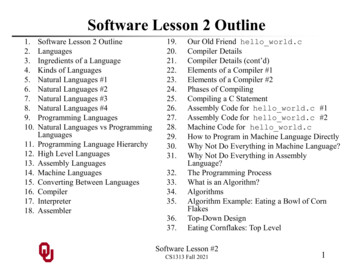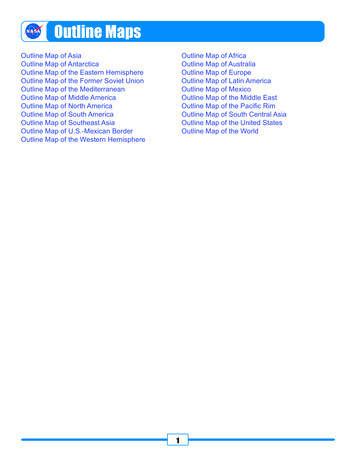
Transcription
Software Lesson 2 8.Software Lesson 2 OutlineLanguagesIngredients of a LanguageKinds of LanguagesNatural Languages #1Natural Languages #2Natural Languages #3Natural Languages #4Programming LanguagesNatural Languages vs ProgrammingLanguagesProgramming Language HierarchyHigh Level LanguagesAssembly LanguagesMachine LanguagesConverting Between 3.24.25.26.27.28.29.30.31.32.33.34.35.36.37.Our Old Friend hello world.cCompiler DetailsCompiler Details (cont’d)Elements of a Compiler #1Elements of a Compiler #2Phases of CompilingCompiling a C StatementAssembly Code for hello world.c #1Assembly Code for hello world.c #2Machine Code for hello world.cHow to Program in Machine Language DirectlyWhy Not Do Everything in Machine Language?Why Not Do Everything in AssemblyLanguage?The Programming ProcessWhat is an Algorithm?AlgorithmsAlgorithm Example: Eating a Bowl of CornFlakesTop-Down DesignEating Cornflakes: Top LevelSoftware Lesson #2CS1313 Fall 20211
Languages What is a language?Kinds of languages Natural languagesProgramming languages (also known as Formal languages)Converting between programming languages CompilersInterpretersAssemblersSoftware Lesson #2CS1313 Fall 20212
Ingredients of a Language Symbols: a set of words and punctuation (in computing,words and punctuation are collectively known as tokens)Grammar (also known as syntax): a set of rules forputting symbols together to get valid statementsSemantics: a set of rules for interpretingthe meaning of a grammatically valid statementSoftware Lesson #2CS1313 Fall 20213
Kinds of Languages Natural languages: used in human communicationProgramming languages (also known as formal languages):used by computers (among others)Software Lesson #2CS1313 Fall 20214
Natural Languages #1 There are said to be 7000 natural languages in the anguages Examples: English, Chinese, Swahili, Navajo, Quechua, MaoriNot all natural languages arise naturally –some are created by people, on purpose.https://en.wikipedia.org/wiki/Incubus (1966 film)https://en.wikipedia.org/wiki/Jabba the Hutt kipedia.org/wiki/WorfTypically can be described by formal rules (grammar),but often aren’t rigidly governed by these rulesin everyday use:“Any noun can be verbed.”“I might could get me one o’ them there computers.”Software Lesson #2CS1313 Fall 20215
Natural Languages #2 CAN mix words from different languages – and evensyntax (elements of grammar) from different languages –in a single sentence:“Hey, amigo, is it all right by you if I kibbitzyour pachisi game while we watch your ftware Lesson #2CS1313 Fall 20216
Natural Languages #3CAN be ambiguous: “When did he say she was going?”could be interpreted as:State the time at which he said, “She was going.”OR According to him, at what time was she going? “You can’t put too much water in a nuclear reactor.”could be interpreted 17-1984-ed-asner-thekinks-s10-e6/You shouldn’t put a lot of water in a nuclear reactor.OR There’s no upper limit to how much wateryou can put in a nuclear reactor. Software Lesson #2CS1313 Fall 20217
Natural Languages #4 Plenty of flexibility regarding “correctness;” for example,“ain’t,” split infinitives, ending a sentence with a preposition.“That is something up with which I will not put.”Software Lesson #2CS1313 Fall 20218
Programming Languages Examples: C, Java, HTML, Haskell, Prolog, SASAlso known as formal languagesCompletely described and rigidly governed by formal rulesCannot mix the words of multiple languages,or the syntax of multiple languages, in the same programCannot be ambiguousWords and syntax must be EXACTLY correct in every waySoftware Lesson #2CS1313 Fall 20219
Natural Languages vs Programming LanguagesPROPERTYNAT’L PROGCompletely described and rigidly governednoYESby formal rulesCAN mix the words of multiple languages,YESnoor the syntax of multiple languages,in the same programCAN be ambiguousYESnoWords and syntax must beEXACTLY correct in every waySoftware Lesson #2CS1313 Fall 2021noYES10
Programming Language Hierarchy High Level LanguagesAssembly LanguagesMachine LanguagesSoftware Lesson #2CS1313 Fall 202111
High Level Languages Human-readableMost are standardized, so they can be used onjust about any kind of computer.Examples: C, Fortran 90, Java, HTML, Haskell, SASTypically they are designed for a particular kind of application;for example: C for operating system designFortran 90 for scientific & engineering applicationsJava for embedded systems (originally designed for interactive TV)HTML for hypertext (webpages)SAS for statisticsBut often, their uses in real life are broader their original purpose.Software Lesson #2CS1313 Fall 202112
Assembly Languages Human-readableSpecific to a particular CPU family; for example: Intel/AMD x86 (PCs, servers, some handhelds)ARM (handhelds such as cell phones and tablets)IBM POWER (server computers)So, for example, a program in x86 assembly languagecannot be directly run on a POWER or ARM machine.Set of simple commands; for example: Load a value from a location in main memoryAdd two numbersBranch to an instruction out of sequenceSoftware Lesson #2CS1313 Fall 202113
Machine Languages Not human-readable, except with immense effortBinary code that the CPU family understands directlyBinary representation of the CPU family’s assembly languageSoftware Lesson #2CS1313 Fall 202114
Converting Between LanguagesCompilers, interpreters and assemblers areprograms that convert human-readable source codeinto machine-readable executable code.Software Lesson #2CS1313 Fall 202115
Compiler Converts a human-readable high level language source codeof a program into a machine language executable programConverts an entire source code all at onceMust be done before executing the programExamples: Fortran, C, C , PascalSoftware Lesson #2CS1313 Fall 202116
Interpreter Converts a human-readable high level language source codeinto actions that are immediately performedConverts and executes one statement at a timeConversion and execution alternateExamples: Perl, HTML, SAS, Mathematica, Unix “shell”(interactive system within Unix)Software Lesson #2CS1313 Fall 202117
Assembler Converts a human-readable CPU-specific assembly codeinto CPU-specific, non-human-readable machine languageLike a compiler, but for a low level assembly languageinstead of for a high level languageSoftware Lesson #2CS1313 Fall 202118
Our Old Friend hello world.c% cat hello *********** Program: hello world****** Author: Henry Neeman (hneeman@ou.edu)****** Course: CS 1313 010 Fall 2021****** Lab: Sec 014 Fridays 2:30pm****** Description: Prints the sentence******"Hello, world!" to standard **********/#include stdio.h int main (){ /* main *//************************************ Execution Section (body) ************************************* Print the sentence to standard output* (i.e., to the terminal screen).*/printf("Hello, world!\n");} /* main */% gcc -o hello world hello world.c% hello worldHello, world!Software Lesson #2CS1313 Fall 202119
Compiler DetailsSoftware Lesson #2CS1313 Fall 202120
Compiler Details (cont’d)Software Lesson #2CS1313 Fall 202121
Elements of a Compiler #1 Lexical Analyzer: identifies program’s “word” elements: Keywords (for example, int, while)Constants (for example, 5, 0.725, "Hello, world!")User-defined identifiers (for example, addend)Operators; for example: Arithmetic: - * / %Relational: ! Logical:&& ! Software Lesson #2CS1313 Fall 2021 22
Elements of a Compiler #2 Parser: determines the program’s grammarSemantic Analyzer: determines what the program doesIntermediate Code Generator: expresses, as anassembly-like program, what the program doesOptimizer: makes code more efficient (faster)Assembly Code Generator: produces the final assembly codethat represents what the program doesSoftware Lesson #2CS1313 Fall 202123
Phases of Compiling CompilerAssembler: turns assembly code into machine codeLinker/loader: turns machine code into an executable fileBoth the assembler and the linker/loader areinvoked automatically by the compiler,so you don’t have to worry about them.Software Lesson #2CS1313 Fall 202124
Compiling a C StatementSoftware Lesson #2CS1313 Fall 202125
Assembly Code for hello world.c #1On Pentium4 Using gccpushl %ebpmovl %esp, %ebpsubl 8, %espsubl 12, %esppushl .LC0call printfaddl 16, %espleaveretOn IBM POWER4 Using gccDifferent opcodes!mflr 0stw 31,-4(1)stw 0,8(1)stwu 1,-64(1)mr 31,1lwz 3,LC.1(2)bl .printfnoplwz 1,0(1)lwz 0,8(1)mtlr 0lwz 31,-4(1)blrSoftware Lesson #2CS1313 Fall 202126
Assembly Code for hello world.c #2On Pentium4 Using gcc(GNU compiler)pushl %ebpmovl %esp, %ebpsubl 8, %espsubl 12, %esppushl .LC0call printfaddl 16, %espleaveretOn Pentium4 Using icc(Intel compiler)Different sequencesof instructions!pushl %ebpmovl %esp, %ebpsubl 3, %espandl -8, %espaddl 4, %esppush STRING.0call printfxorl %eax, %eaxpopl %ecxmovl %ebp, %esppopl %ebpretSoftware Lesson #2CS1313 Fall 202127
Machine Code for hello 00101010100101010101101010101011010.Software Lesson #2CS1313 Fall 202128
How to Program in Machine Language Directly1.2.3.4.Write the assembly code for the program directly by hand;that is, not in a high level language.For each assembly language instruction, look up the bit patternof the associated machine code.On the computer console, flip switches to match the bit patternof the machine code.Press the “Run” button.On modern computers, programming directly in machine languageis just about impossible.Software Lesson #2CS1313 Fall 202129
Why Not Do Everything in Machine Language?Incredibly tedious and ridiculously error-prone!Fun and easy!Not nearly as tedious or error-prone!Software Lesson #2CS1313 Fall 202130
Why Not Do Everything in Assembly Language?Can’t be run on any other kind of computer.May be completely obsolete in a few years.Portable to many kinds of computers.Will still be usable in 20 years(“legacy” codes).Software Lesson #2CS1313 Fall 202131
The Programming ProcessFormulateProblemCompileConstruct AlgorithmBugs?YesDebugNoChoose ProgrammingLanguageWrite ProgramRunBugs?YesNoGet an A/Impress Your Boss/Sell for Zillions!Software Lesson #2CS1313 Fall 202132
What is an Algorithm?An algorithm is: a step-by-step method that is written in a natural language (for example, English)or in pseudocode (something that sort of looks likea programming language but isn’t as precise),instead of in a programming language, that solves a well-defined (though not necessarily useful)problem, on a well-defined set of inputs (which may be empty), using finite resources (for example,computing time and storage), and that produces a well-defined set of outputs(which may be empty).Software Lesson #2CS1313 Fall 202133
AlgorithmsAn algorithm is a language-independent way of expressingthe method of solving a problem; that is, an algorithm couldbe expressed in two different languages (for example,English and Japanese) and still be the same algorithm.A program, by contrast, is a language-dependentimplementation of the method of solving a problem;that is, the same set of steps expressed intwo different programming languages would betwo different programs, even if the two programsaccomplished exactly the same result.Many programs, but not all, implement algorithms.Programs that don’t implement algorithms often implementheuristics, which typically are inexact but good enough.The word “algorithm” comes from the name of the 9th centurymathematician, Muhammad ibn Musa hmSoftware Lesson #2CS1313 Fall 202134
Algorithm Example: Eating a Bowl of Corn Flakes Get bowl from cupboardGet spoon from drawerGet box of corn flakes frompantryGet jug of milk fromrefrigeratorPlace bowl, spoon, cornflakes and milk on tableOpen box of corn flakesPour corn flakes from boxinto bowlOpen jug of milkPour milk from jug into bowlClose jug of milkGo to tablePick up spoon Repeat until bowl is empty ofcorn flakes Using spoon, pick up cornflakes and milk from bowlPut spoon with corn flakesand milk into mouthPull spoon from mouth,leaving corn flakes and milkRepeat . Chew. until mouthful is mushSwallowLeave mess for housemates toclean upSoftware Lesson #2CS1313 Fall 202135
Top-Down DesignAlgorithms for most non-trivial problems tend to be fairlycomplicated.As a result, it may be difficult to march from an algorithm’sbeginning to its end in a straight line, because there may betoo many details to keep in your head all at one time.Instead, you can use a technique called top-down design:start with the whole problem, then break it into a few pieces,then break each of those pieces into a few pieces, then breakeach of those pieces into a few pieces, and so on, until eachpiece is pretty small.Software Lesson #2CS1313 Fall 202136
Eating Cornflakes: Top Level Get stuffTransport stuffSet up stuffEatFinishSoftware Lesson #2CS1313 Fall 202137
Programming Languages Examples: C, Java, HTML, Haskell, Prolog, SAS Also known as formal languages Completely described and rigidly governed by formal rules Cannot mixthe words of multiple languages, or the syntax of multiple languages, in the same program Cannot be ambiguous Words and syntax must be EXACTLY correct in every way










